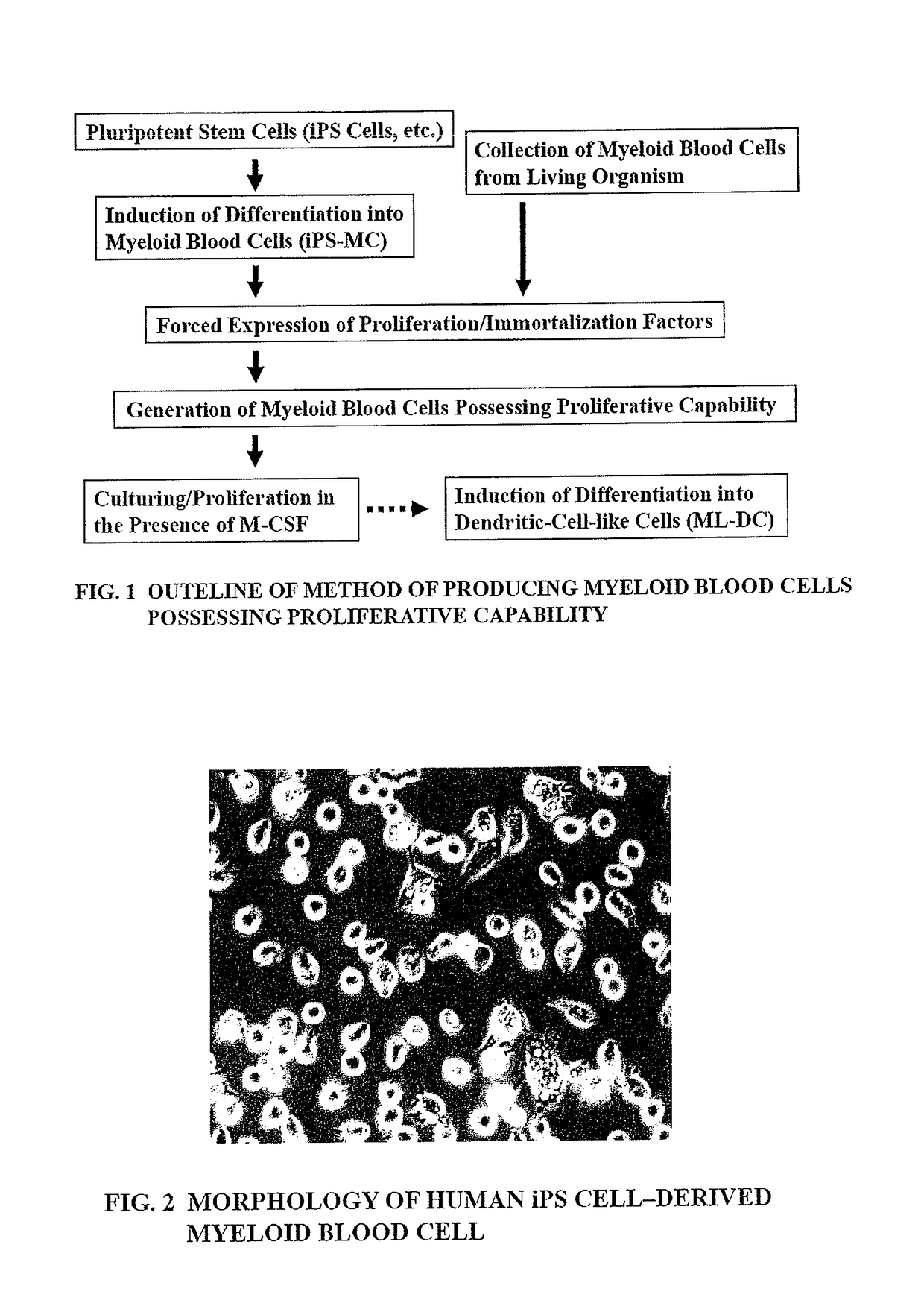Method of producing myeloid blood cells
a technology of myeloid blood cells and blood cells, which is applied in the field of human myeloid blood cells production, can solve the problems of limited number of living organisms that exist in living organisms, cell deaths occur daily and it is difficult to collect a large number of living organisms of these cells, so as to supply myeloid blood cells, stably produce myeloid blood cells, and in a large number
- Summary
- Abstract
- Description
- Claims
- Application Information
AI Technical Summary
Benefits of technology
Problems solved by technology
Method used
Image
Examples
example 1
n of Lentivirus Vectors
[0116]cDNAs of human OCT3 / 4, SOX2, KLF4, and c-MYC, which are reprogramming factors, were synthesized by means of PCR, and cloning was performed by inserting them into plasmid vectors (pENTR-D-TOPO, Gibco-Invitrogen). Then, nucleotide sequences of the cloned plasmid DNAs were confirmed by means of sequence analysis. cDNA clones of human BMI1, EZH2, MDM2, MDM4, and HIF1A were obtained from RIKEN BioResouce Center, Gene engineering division or National Institute of Technology and Evaluation.
[0117]The aforementioned cDNA fragments were inserted into lentivirus vectors (CSII-EF-RfAl, provided by Dr. Hiroyuki Miyoshi at RIKEN) by using LR clonase (Gibco-Invitrogen).
[0118]By means of lipofection (using Lipofectamine 2000, Invitrogen), the individual genes introduced into CSII-EF produced as described above, packaging constructs (pCAG-HIVgp, provided by Dr. Miyoshi), envelopes, and Rev constructs (pCMV-VSV-G-RSV-Rev, provided Dr. Miyoshi) were introduced into 293T ce...
example 2
Human Artificial Pluripotent Stem (iPS) Cells
[0120]A skin fragment was collected from a human abdomen and cultured in a cell culture plate by using a culture solution (DMEM / 10% bovine serum). Because migration and proliferation of fibroblasts from the skin fragment were observed starting from the first week after culturing started, the fibroblasts were appropriately recovered and freeze-stored by using a trypsin / EDTA-containing phosphate-buffered saline solution (trypsin-EDTA).
[0121]The freeze-stored human fibroblasts were thawed, cultured again for several days, and, subsequently, gene introduction was performed in the culture plate by adding, at the same time, the lentivirus vectors that express OCT3 / 4, SOX2, KLF4, and c-MYC, which had been produced and freeze-stored as described above.
[0122]Four to six days after the gene introduction, infected cells were recovered by using trypsin-EDTA, and co-culturing thereof was started together with mouse-fetus-derived fibroblasts (feeder ce...
example 3
iation Induction of Human Artificial Pluripotent Cells into Myeloid Blood Cells (iPS-MC)
(1) Preparation of OP9 Feeder Cells
[0125]Mouse-derived cultured cell line OP9 treated with mitomycin C (with 0.01 mg / ml for 60 min.) was inoculated into a gelatin-coated dish, and was used next day or later.
(2) Differentiation Induction Culturing
[0126]Undifferentiated iPS cells were treated for five to ten minutes using a CTK solution and recovered in a DMEM culturing solution containing fetal calf serum (FCS). The cells were suspended in α-MEM / 20% FCS, and inoculated onto the OP9 feeder cells, thus starting differentiation induction culturing. Thereafter, the culturing was continued while exchanging the culture solution (α-MEM / 20% FCS) once every three days.
[0127]Eighteen days after differentiation induction started, the cells were recovered by dissociating them by means of treatment using a trypsin-EDTA (ethylenediamine tetraacetic acid)-collagenase solution (at 37° C. for 60 min.), and a cell ...
PUM
| Property | Measurement | Unit |
|---|---|---|
| time | aaaaa | aaaaa |
| diameter | aaaaa | aaaaa |
| doubling time | aaaaa | aaaaa |
Abstract
Description
Claims
Application Information
 Login to View More
Login to View More - R&D
- Intellectual Property
- Life Sciences
- Materials
- Tech Scout
- Unparalleled Data Quality
- Higher Quality Content
- 60% Fewer Hallucinations
Browse by: Latest US Patents, China's latest patents, Technical Efficacy Thesaurus, Application Domain, Technology Topic, Popular Technical Reports.
© 2025 PatSnap. All rights reserved.Legal|Privacy policy|Modern Slavery Act Transparency Statement|Sitemap|About US| Contact US: help@patsnap.com



